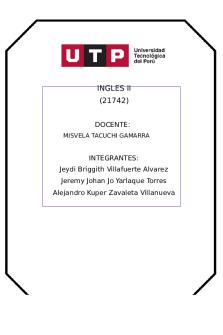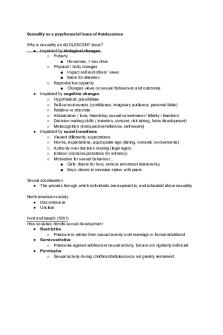Ps276 week 6 PDF

| Title | Ps276 week 6 |
|---|---|
| Author | nicole krasnopolski |
| Course | Introduction to Developmental Psychology: Adolescence and Young Adulthood |
| Institution | Wilfrid Laurier University |
| Pages | 5 |
| File Size | 89.6 KB |
| File Type | |
| Total Downloads | 19 |
| Total Views | 135 |
Summary
Introduction to Developmental Psychology: Adolescence and Young Adulthood PS276...
Description
Contexts: School General information ● Canadian adolescents and school: ○ Middle school ○ Grade 7 and 8 (6-2-4 system) ○ Grade 6,7,8 (5-3-4 system) ● Majority in public schools ● 6% private ● 1% home schooled Private or public school? ● 7,142 canadian high school students (15-23) ● On average, private high school students: ○ Scored higher on academic tests at age 15 ○ Had higher levels of educational attainment by age 23 than public high school students What accounts for the difference in academic outcomes? ● NOT resources/practices/curricula (these were similar) INSTEAD: ● 1. SES (higher parent income and parent education) ● 2. Peers (higher parental education) ○ Private students have better outcomes due to having parents with higher income and education … and being surrounded by peers who have parents with higher education B.C Study ● Public school students advantaged at university ○ Used to little individual attention ● Private school students suffer ○ Used to intensive and personal instruction ○ More difficult to adjust to the required independent study and self-discipline Functions of schools Active functions: ● Training ○ Job and workforce preparation (apprenticeship, etc) ● social/cultural transmission ○ Expose adolescents to formal and informal social/cultural situations more often, more systematically, and with more variation than any other social institution or setting ● Instilling knowledge and values ○ General education
Latent functions: ● Baby sitting ○ Custodial role ○ Compulsory; highly structures time and activities ○ Something to do, someplace to be, during the long transition phase ● Providing a place for adolescents to socialize and develop relationships ● Context in which adolescents discover, experience, and shape their notions of personal status
Earn status in school by: ● Mastering the curriculum ● Achieving high class standing ● Non-academic interactions in school activities ● Community engagement and volunteering Highschool prep for university ● Highschool is structured to provide the necessary background skills, knowledge and socialization needed for further education School ● Underachievement ● Failure ● Drop out (early school leaving) ● Those who dont continue to university after highschool -> “the forgotten half” ● Early high school leavers - forgotten too? Implications of leaving school early ● Remaining in school is the single most important action youth can take to improve theory future economic prospects Education associated with higher earnings ● Possible downward social mobility ○ Early leavers may arrive at lower socioeconomic position than parents Factors associated with school underachievement, failure, and dropping out (early leaving) 1. Individual 2. Peers 3. Family 4. Community 5. School setting
1. Individual variables ● Cognitive / learning abilities ○ Disabilities, academic struggles ● Motivation ○ Interest, mastery/performance goals; attributions ● Personality ○ Performance-avoidance; fear of failure; self-handicapping ● Gender (more males than females) ● Personal situations ○ pregnancy/dependents, self-supporting 2. Peer variables ● Reputation, status, acceptance ● Peer attitudes/ support ● Social vs antisocial peer behaviours 3. Family variables ● Parenting styles ● Family structure/dynamics ● Family values 4. Community variables ● Poverty (SES) ○ Few resources ○ Low collective efficacy ○ Impact on tracking in highschool ■ Toronto study: low income = programs with no prep for university; put in work placement programs ○ Leave school to work ● Social support for learning/opportunities ● After-school programs 5. School setting ● School climate ● Classroom environment ● Opportunities for involvement (extracurriculars) ● Type of students (peer exposure) ● Teacher variables (adolescents) ○ Encourage interest, application persistence = > academic self-efficacy ○ support/fairness/grant some autonomy = > attachment to learning ○ Teaching style - authoritative is best ○ attitudes/expectations ■ Teacher efficacy ■ Destructive cycle:
●
○ ○
Lack of teaching confidence -> less effort/ engagement in teaching -> poor student performance (feelings of alienation) -> reduced confidence in teaching etc Educational self-fulfilling prophecy Grade transitions
How does university attendance impact young people? ● Gain in factual knowledge, cognitive/intellectual skills, and a broad array of value, attitudinal psychosocial and moral dimensions Gains in learning/cognition ● Increased knowledge of major field ● Gains in: ○ Effective speaking/writing ○ Abstract reasoning, problem solving, cognitive flexibility, organization ● More functionally adaptive in learning and non learning situations Changes in attitudes/values ● Increased valuing of and interest in art, culture and ideas ● Increased importance on liberal education and exposure to new ideas ○ Openness ○ Tolerance for diversity ○ Other orientation ○ Concern for individual freedom, inclusiveness, human welfare ● Shift from extrinsic to intrinsic rewards ● More value on broad education; less on vocational prep Psychosocial changes ● Increased: ○ Ability to examine identities, self-concepts, interactions ○ Self understanding ○ Personal adjustment ○ Sense of well-being ○ Maturity ● academic/social self-image, and self-esteem ‘recovers’ and becomes more positive Moral development ● Shifts from conventional to post conventional/principled reasoning University context: ● Integrated change across many aspects of development ● Changes do not result simply from learning new material but also from: ○ Time (maturation) ○ Developmental opportunities
○
Social and life experiences the university years provide...
Similar Free PDFs

Ps276 week 6
- 5 Pages

Week 6 Week 6 Week 6Week 6
- 2 Pages

Week 6 ingles Week 6
- 2 Pages

Week 6 Assignment - Week 6
- 11 Pages

Lecture 6 - week 6
- 32 Pages

Week 6 Study Notes - week 6
- 6 Pages

Week 6 - Lecture notes 6
- 20 Pages

Week 6 - Lecture notes 6
- 11 Pages

WEEK 6 - Synaesthesia
- 6 Pages

Tutorial week 6
- 2 Pages

Reading log - Week 6
- 7 Pages

Week 6 notes - Corporations
- 9 Pages

Week6 - week 6
- 4 Pages

Week 6 CIVL2340 2018
- 2 Pages
Popular Institutions
- Tinajero National High School - Annex
- Politeknik Caltex Riau
- Yokohama City University
- SGT University
- University of Al-Qadisiyah
- Divine Word College of Vigan
- Techniek College Rotterdam
- Universidade de Santiago
- Universiti Teknologi MARA Cawangan Johor Kampus Pasir Gudang
- Poltekkes Kemenkes Yogyakarta
- Baguio City National High School
- Colegio san marcos
- preparatoria uno
- Centro de Bachillerato Tecnológico Industrial y de Servicios No. 107
- Dalian Maritime University
- Quang Trung Secondary School
- Colegio Tecnológico en Informática
- Corporación Regional de Educación Superior
- Grupo CEDVA
- Dar Al Uloom University
- Centro de Estudios Preuniversitarios de la Universidad Nacional de Ingeniería
- 上智大学
- Aakash International School, Nuna Majara
- San Felipe Neri Catholic School
- Kang Chiao International School - New Taipei City
- Misamis Occidental National High School
- Institución Educativa Escuela Normal Juan Ladrilleros
- Kolehiyo ng Pantukan
- Batanes State College
- Instituto Continental
- Sekolah Menengah Kejuruan Kesehatan Kaltara (Tarakan)
- Colegio de La Inmaculada Concepcion - Cebu

